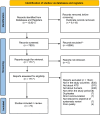Non-typhoidal Salmonella in humans in India, Vietnam, Bangladesh and Sri Lanka: a systematic review
- PMID: 39600875
- PMCID: PMC11589464
- DOI: 10.1093/jacamr/dlae190
Non-typhoidal Salmonella in humans in India, Vietnam, Bangladesh and Sri Lanka: a systematic review
Abstract
Objectives: Non-typhoidal Salmonella (NTS) commonly causes a self-limiting illness but invasive disease (iNTS) can be life-threatening. Antimicrobial resistance (AMR) increases the risk of mortality. This systematic review aimed to estimate the proportion of NTS isolated in those attending healthcare services, serovar burden, AMR, serovar-specific AMR, and case fatality rate (CFR) in India, Bangladesh, Sri Lanka and Vietnam.
Methods: The review included quantitative studies on NTS and AMR from 1980 to 2020 but excluded studies unrelated to humans or selected countries. Data were extracted from articles identified from Ovid SP, Web of Science, Wiley Cochrane Library, Elsevier Scopus and WHO Global Index Medicus. The Joanna Briggs Institute Critical Appraisal Tools Checklist for Prevalence Studies was used for risk-of-bias assessment. Meta-analyses were performed for the proportion of NTS isolated, the proportion of specific serovars isolated, percentage of AMR and CFR.
Results: Six thousand and twenty-six isolates (79 serovars) were identified from 73 studies, with Salmonella enterica serovar Typhimurium being the most common. Of the 73 selected studies, 46% were hospital/laboratory surveillance studies, examining the aetiology of invasive or non-invasive infections. The pooled proportion estimate for non-iNTS was 2.1% (95% CI: 1.2%-3.2%) and for iNTS was 0.3% (95% CI: 0.1%-0.5%). The pooled CFR was 14.9% (95% CI: 4.0%-29.6%). Pooled resistance estimates for ampicillin, ceftriaxone, chloramphenicol, ciprofloxacin, co-trimoxazole, nalidixic acid and azithromycin were calculated. MDR iNTS was less prevalent in India [22.3% (95% CI: 0.0%-66.8%)] than in Vietnam [41.2% (95% CI: 33.6%-49.3%)]. Heterogeneity of studies was high as the majority were observational surveillance studies.
Conclusions: Despite data scarcity in some countries, this review highlights the continued contribution of NTS infection to disease burden, compounded by high AMR rates.
© The Author(s) 2024. Published by Oxford University Press on behalf of British Society for Antimicrobial Chemotherapy.
Figures




References
-
- Institute for Health Metrics and Evaluation . Diarrheal diseases—Level 3 cause. https://www.healthdata.org/research-analysis/diseases-injuries-risks/fac....
Publication types
LinkOut - more resources
Full Text Sources
